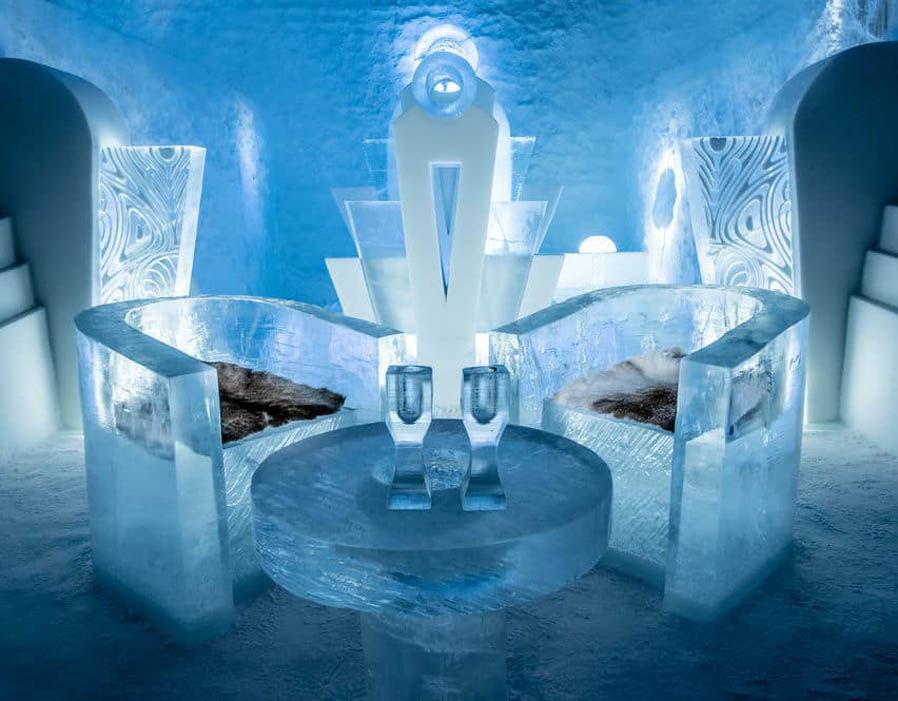Baby, it’s cold INSIDE!
A look at the Ice Hotels around the world
March 27, 2018
I don’t know about any of you, but over the course of winter break, I asked my parents to turn up the heat at least three times. If you’re like me, without a high affinity for the cold, you probably cannot imagine voluntarily making the choice to stay in below-freezing temperatures all day. However, there are exceptions, and I personally think ice hotels are something to behold.
Ice hotels are exactly what they sound like. These huge buildings are composed entirely out of ice and snow. Bundled-up visitors come from around the world to stay. The first opened in 1990 and has inspired others like it since.

The first of its kind is known simply as ICEHOTEL, but nothing about its construction is simple. Artists from around the world gather yearly in Jukkasjärvi, northern Sweden, to construct it. In its early years, ICEHOTEL was nothing more than an igloo, taking up less than 200 square feet, but some have grown to the size of two football fields. The decorations are nothing less than intricate. No matter where you go, you are surrounded by frozen artwork. Everything is an elegant ice sculpture. It attracts some 50,000 tourists annually.
Assiduous work- and thousands of tons of ice- go into the construction of an ice hotel. Workers endure horrible, truculent conditions. During this race against time, the sun hardly reaches above the horizon. The colder it is, the easier the snice- snow and ice mixture- is to work with. They labor in thirty degrees below freezing, and if the temperature and weather don’t cooperate, all the snice inventory can be lost. The ice needs to be at the perfect density for it to last all season. If the density is too low, the snow will be too powdery and impossible to form shapes. On top of all of this, the hotel needs to be completed in two months’ time, with nature’s will hampering their progress.

The international sensation starts in the summer when crystal clear ice is harvested and stored for winter assembly. The architects and engineers construct gigantic models of how the hotel will look to find any mistakes early on. Over time, the hotel will shrink due to air escaping from the ice, so all measurements must be exact. Any imperfections unnoticed will cause major problems later on, because the pressure of snow put on the model cast later may cause it to give. Once deemed worthy, tons of snow are coated over the metal cast. These walls need to be made thick, to compensate for melting during the season. Once the snow hardens to a durable solid, the cast can be removed so the ice structure can stand on its own, strong as stone.
Each year the look of the exterior and interior of the hotel are changed. All ideas have to be adaptable. The art of ice hotels rides upon predictions in a protean environment. If something takes up too much time in the beginning, it must be done away with immediately so it will not slow down the operation. Arches are a favorite in design because they are a resilient shape and hold up the snow well. Each room is diverse because a different artist creates each one. Thankfully, snice is an easy material to work with. Gorgeous chandeliers are assembled, with everything from the shape to the lightbulbs made of ice. Bathrooms are located in separate trailers because there is no plumbing. Visitors sleep in sleeping bags that cover everything except for their faces. For warmth and comfort, reindeer skins serve as blankets. Although born of the cold, the interior will still be warmer than the exterior because the walls trap heat and block wind.

The creation of the hotel continues until the very last minute, when the arrival of the guests begin. Visitors are transported from the airport to the hotel not by a car but by dog sled taxi. Guests wear fleece and silk, which are water resistant materials, because other materials like cotton absorb moisture and become very cold, very fast. While on vacation there, some hotels only allow the tourists to stay in the ice hotel one night. Being so heavily covered for too long makes a person sweat too much, increasing the susceptibility of freezing. Therefore, for the rest of their stay they sleep in different hotels in the resort warmed like any other. The visitors have lots to do during their stays. They can sip drinks in bars where no ice cubes are required because the glass itself is made of ice. Some come to be married in beautiful chapels. They can sit back in the theatres to watch Shakespearean plays, operas, and dance and music shows. The tourists, depending on the location they choose, can go snow rafting, sledding, ice skating, skiing, snowshoeing, compete in sculpting competitions, and view the northern lights. Kings and queens have even come to stay.

The ice hotel is a lifecycle. Ice is taken from rivers to be sculpted into a majesty, with water and the cold being the only glue holding it all together. With the end of the season in Spring, the hotel melts to ruin, leaving only a memory of what once was. Whatever is left is brought back to its original source, where it awaits its next adventure. The art cannot last, but water remains a true recyclable material for the next season.
For those of us who would rather cuddle up by the fireplace with some hot cocoa, we can still admire the extreme engineering of ice hotels from afar in awe.
Special thank you to George and Erin for speaking to me about their time at the Hôtel de Glace in Quebec, where they got engaged.














































